Grunewald
ranks with Direr as the greatest German painter of the Renaissance. After
obscure beginnings, he forged a successful career for himself at the court of
the Archbishop of Mainz, where he was valued not only for his painting, but
also for his skills as an engineer and his services as a courtier. Yet although
he attended the Archbishop at the lavish coronation of Charles V. the artist
himself was an austere character.
Grunewald
specialized in emotive religious scenes which contained a unique blend of
brutal realism, visionary power and brilliant, luminous colouring. The
altarpiece at Isenheim has been acclaimed as the last great painting of the
middle Ages. Grunewald was receptive to new ideas but his attachment to the
Lutheran cause brought about his dismissal from Mainz. He settled in Halle,
where he died of the plague.
The Artist’s Life
Riches to Rags
For most of his career Grunewald enjoyed
the trappings of a successful court painter-yet he died a plague-ridden pauper,
having fallen from official favour because of his religious beliefs.
MATHIS GRUNEWALD
The
painter known to us as Mathis Grunewald was, in fact, called Mathis Gothardt or
Neithardt. The initial error over his name derived from the first biographical
study on him, written in 1675, by the German painter and traveler, Joachim von
Sandrart. Perhaps confusing him with another German artist, Baldung Grien,
Sandrart bestowed on Gothardt the erroneous name which has become his permanent
identity.
Key Dates
c.1474 born in Wurzburg
1504 begins work on his first known
painting, The Mocking of Christ
c.1508-14 court painter to Uriel
von Geminingen, Archbishop of Mainz
c.1512-15 works on The Isenheim
altarpiece
1516- enters service of
Cardinal Albrecht.
1520- attends coronation of
Charles V. Meets DUrer
1520-23 in Halle, advising on
the construction of Albrecht's new collegiate church
1525-26 peasant's revolt. Grunewald
dismissed. Flees to Frankfurt
1527 moves to Halle 1528 dies of
the plague
EARLY CAREER
Grunewald
was born in Wurzburg sometime between 1470 and 1480. Nothing is known about his
early life, other than suggestions that he may have carried out his training in
the studio of Holbein the Elder at Augsburg.
 Information
about the initial development of Grunewald’s career is sadly limited and still
hotly disputed. A 'free', that is a qualified, master called Mathis is recorded
at Seligenstadt in 1501 this may be Grunewald. Seligenstadt, situated on the
river Main in northern Bavaria, had no great artistic traditions itself, but it
came within the diocese of the Archbishop of Mainz so, although a fairly small
town, it enjoyed certain privileges. The t; town's charter may have helped
Grunevvald gain access to the Archbishop's court, a powerful source 4 of
patronage in the region. At any rate, this it connection with the Archbishop
had been made By 1504, when Grunewald
began work on The Mocking of Christ for Johan von Cronberg, the representative
of the Archbishop in Ascha ffenburg.
Information
about the initial development of Grunewald’s career is sadly limited and still
hotly disputed. A 'free', that is a qualified, master called Mathis is recorded
at Seligenstadt in 1501 this may be Grunewald. Seligenstadt, situated on the
river Main in northern Bavaria, had no great artistic traditions itself, but it
came within the diocese of the Archbishop of Mainz so, although a fairly small
town, it enjoyed certain privileges. The t; town's charter may have helped
Grunevvald gain access to the Archbishop's court, a powerful source 4 of
patronage in the region. At any rate, this it connection with the Archbishop
had been made By 1504, when Grunewald
began work on The Mocking of Christ for Johan von Cronberg, the representative
of the Archbishop in Ascha ffenburg.
About
1508, Grunewald was appointed court painter to Archbishop Uriel von Gemming.
This was a prestigious post which he held until Uriel's death in 1514. In
recognition of his status, the Archbishop granted him a coat of arms and
presented him with elegant court wear including a shirt with an embroidered
gold collar, a lined purple cloak and yellow kneebreeches.
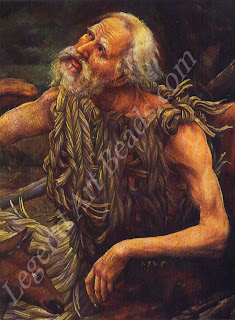
The
records of Grunewald’s employment with Uriel show that his talents extended
beyond painting. He was a skilled hydraulic engineer and, on several occasions,
was called in to advice on the construction of fountains. Moreover, in his
capacity as the court's leading art official, he was also expected to supervize
new building work. In 1511 he was sent to Aschaffenburg to oversee the
rebuilding of the Archbishop's palace. Shortly afterwards, Grunewald embarked on
the work that was to prove his masterpiece The Isenheim Altarpiece for the
Anthonite Abbey. The Anthonite Order had originated in France at the end of the
11th century and was dedicated to the care of the sick. In particular, it
tended for those suffering from the 'burning sickness' or the plague, for which
St Anthony and St Sebastian (both prominently featured in the altarpiece) were
the protecting saints.
With
the repeated outbreaks of the plague, the Anthonite set .up a series of
hospices at major road junctions in Europe, and the small village of Isenheim,
in Alsace, was chosen as one of these sites because it stood on the important
trade route joining the Rhine Valley and the Mediterranean. , The Preceptor at
Isenheim, Guido Gaersi, had doubtless heard of Grunewald's work for the diocese
of Mainz and commissioned an altarpiece for the hospital chapel. Patients were
taken there ,=5, before receiving medical treatment in the hope that the
intercession of St Anthony might effect a miracle cure or, at the very least,
bring them some spiritual comfort.
AN AUSTERE REALIST
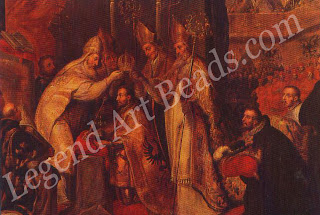 Grunewald’s
awesomely realistic depiction of the agonies of Christ was unparalleled in
Western art. With its concentration on the physical sufferings shared by the
Lord and the joys of redemption which He offered, it was designed to bolster
the faith of the sick at a time when it might understandably have faltered. In
precisely the same way, the panel illustrating The Temptation of St Anthony showed
the trials of the saint mirrored in the torments of a plague victim. The very
little that we know of Grunewald’s personal life accords well with the austere
nature of the altarpiece. Sandrart tells us that he was a melancholy and
withdrawn character, whose marriage, late in life, proved a most unhappy one.
Grunewald’s
awesomely realistic depiction of the agonies of Christ was unparalleled in
Western art. With its concentration on the physical sufferings shared by the
Lord and the joys of redemption which He offered, it was designed to bolster
the faith of the sick at a time when it might understandably have faltered. In
precisely the same way, the panel illustrating The Temptation of St Anthony showed
the trials of the saint mirrored in the torments of a plague victim. The very
little that we know of Grunewald’s personal life accords well with the austere
nature of the altarpiece. Sandrart tells us that he was a melancholy and
withdrawn character, whose marriage, late in life, proved a most unhappy one.
There
is no concrete evidence to confirm the existence of his wife but Grunewald
certainly had an adopted son called Andreas Neithardt. In fact, the boy's name
is responsible for much of the confusion over Grunewald’s identity, for it
appears that in documents relating to his son, the painter termed himself
'Neithardt' instead of using his own family name. Grunewald completed The
Isenheim Altarpiece by 1515 and within a year had joined the service of the new
Archbishop of Mainz. Uriel's successor, Albrecht of Brandenburg, was an even
more distinguished figure than Grtinewald's earlier benefactor. He had been the
Archbishop of Magdeburg before becoming Bishop and Elector of Mainz and, in
1518, was finally created a cardinal. For a full decade, his patronage kept Grunewald
at the very pinnacle of his proression.
THE CARDINAL'S COURT
Albrecht
employed the artist in much the same manner as his predecessor. In addition to
his painting, Grunewald was required to manage all building projects. From 1520
to 1523, he worked away from home in nearby Halle, where Albrecht was
constructing a new collegiate church. The most impressive of Grtinewald's
surviving works for Albrecht was, in fact, produced for Halle. The Disputation
of St Erasmus and St Maurice formed part of a huge decorative scheme in the new
foundation, which housed over 6000 relics, including the head and bones of St
Erasmus. 5 The commission was a blatant piece of self- , glorification, with
Albrecht portrayed in the guise 1156 of the martyred saint.
Grunewald's
exalted position in the Cardinal's entourage must also have assisted in gaining
him further commissions, such as the one from Canon Reitzmann to depict the
legend of The Miracle of the Snows. The cult had been introduced into Ger-many
by Uriel and Reitzmann had written a study of the subject, dedicated to
Albrecht. In October 1520, Grunewald accompanied the Cardinal to AixlaChappelle
for the coronation of Emperor Charles V. The occasion finally gave him the
opportunity to meet his great compatriot, Albrecht Duren the two men had
previously been involved on the same project The Heller Altarpiece but each had worked on their contributions
quite independently. In his diary, Dilrer recorded that he presented Grunewald
with two florins' worth of his woodcuts and engravings. In contemporary this
was a sizeable gift and illustrates the steem in which he held his fellow
artist.
The
coronation may, hoverer, has had a secondary and less auspicious effect on renewal’s
life. It seems probable that the spectacle of so much wealth and luxury at Aix
appalled the ascetic nature of the painter and encouraged his sympathies for
the growing Protestants cause. In Germany, this movement entered around the
actives of Martin Luther. And; renewal’s later allegiance to the ideals of
rotestantism cannot be disputed. Among the effects found after his death, there
was discovered much Lutheran trash'. This included 27 of other’s sermons, the
possession of which, alone, 'as a punishable offence.
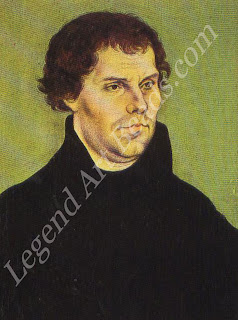 In
addition, there is clear evidence that; Grunewald had already been profoundly
influenced by the mystical writings of St Bridget of weden. This holy woman
spent part of her life in .come, caring for the poor and sick, and speaking, §
us against the corruption of the Pope, whom she penny described as 'a murderer
of souls, like to
In
addition, there is clear evidence that; Grunewald had already been profoundly
influenced by the mystical writings of St Bridget of weden. This holy woman
spent part of her life in .come, caring for the poor and sick, and speaking, §
us against the corruption of the Pope, whom she penny described as 'a murderer
of souls, like to
Mathis Grunewald
Decorative
fountains Grunewald was not simply a talented and successful painter, he was
also a skilled hydraulic engineer. And in his capacity as official artist to
the Archbishop's court Ile was frequently called upon to advice on the
construction of the highly decorative type of fountain which was popular in
16thcentury Germany.
Lucifer
in envy, more unjust than Pilate, more severe than Judas'. Bridget's Revelations
were first published in 1492, and the 1502 edition, issued in Nuremburg with
woodcut illustrations, gained widespread popularity in Germany. Its sombre and
earnest tone probably accounts for much of the intensity and the strange
imagery in Grunewald's work.
THE PEASANTS' REVOLT
The
Protestant troubles came to a head in 1525 with the Peasants' Revolt. Similar
insurrections had occurred before, but never on such a vast scale. Nearly the
whole of southern Germany was affected, with castles and monasteries looted and
their occupants slaughtered. Initially, Luther lent his backing to the
uprising, issuing 'Twelve Articles' in support of the peasant's claims copies
of which were also found among Grunewald’s belongings. However, as the
bloodshed increased, he reversed his position and condemned the rebels as
murderers and thieves. The diocese of Mainz did not escape the violence. In
Halle, there were riots and Cardinal Albrecht's t life was only saved by the intervention
of his chaplain, Winkler, who had Protestant connections. In Aschaffenburg, the
Archbishop's representative was forced to surrender to the ;71 marauding
rebels.
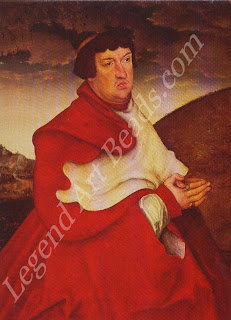
Grunewald
was deeply influenced by two powerfully religious figures - St Bridget of
Sweden and Martin Luther. Bridget, an intense and mystical woman, recorded her
visions, which dwelt on the physical sufferings of Christ, in her Revelations. Grunewald
knew the 1502 edition; published by a relative of airier. Its sombre woodcuts
influenced his work and its criticism of church corruption fuelled his
sympathies to the teachings of Luther which were gaining popularity all over
Germany.
Lucifer
in envy, more unjust than Pilate, more severe than Judas'. Bridget's
Revelations were first published in 1492, and the 1502 edition, issued in
Nuremburg with woodcut illustrations, gained widespread popularity in Germany.
Its sombre and earnest tone probably accounts for much of the intensity and the
strange imagery in Grunewald's work.
THE PEASANTS' REVOLT
The
Protestant troubles came to a head in 1525 with the Peasants' Revolt. Similar
insurrections had occurred before, but never on such a vast scale. Nearly the
whole of southern Germany was affected, with castles and monasteries looted and
their occupants slaughtered.
Initially,
Luther lent his backing to the uprising, issuing 'Twelve Articles' in support
of the peasant's claims - copies of which were also found among Grunewald’s
belongings. However, as the bloodshed increased, he reversed his position and
condemned the rebels as murderers and thieves. The diocese of Mainz did not
escape the violence. In Halle, there were riots and Cardinal Albrecht's t life
was only saved by the intervention of his chaplain, Winkler, who had Protestant
connections. In Aschaffenburg, the Archbishop's representative was forced to
surrender to the; 71 marauding rebels.
These
successes were short lived. Within months, the uprising was suppressed and the
inevitable reprisals followed, during which thousands of rebel peasants were
summarily executed. In 1526, Albrecht returned to Aschaffenburg to preside over
the trials of some of the insurgents. Participants in the rioting were harshly
dealt with and those under suspicion were dismissed from his service.
Seligenstadt lost its charter and the local guilds were deprived of their
ancient privileges. Grunewald, as a knowing sympathizer, was among those
dismissed. He received his final payment in February 1526. The same year Simon
Franck replaced him as court painter.
THE ROAD TO RUIN
Perhaps
fearing further punishment, Grunewald fled to Frankfurt. This was a logical
choice for, as a free imperial city, Frankfurt must have seemed a safe haven
from the jurisdiction of Mainz. Before leaving, Grunewald arranged the apprenticeship
of his son, Andreas, to Arnold Rucker, a carver and cabinet-maker. It is
possible that this Rucker had shared his studio in Seligenstadt. Alhdreas
himself is documented up until 1552, when he was recorded seeking official
permission to teach in a school in Frankfurt.
 The
last few years of Grunewald's career were a Miserable period, in which, as far
as can. Be gathered, he was scarcely able to paint and was compelled to scratch
together a meager living through an assortment of menial jobs. In Frankfurt, he
stayed at 'the Unicorn', the house of a silk-embroiderer called Hans von
Saarbrucken. While resident there, Grunewald’s principal occupation was as a
salesman of artist's colours and of a curative balm, the formula for which he
had presumably learnt from his friends at the hospital in Isenheim. He also
received a commission from the city of Magdeburg to produce technical drawings
of the mills situated along the river Main. However, it appears that Grunewald
left Frankfurt before this task was completed. In the summer of 1527, Grunewald
became convinced that he was being spied upon and that his life was in danger.
He therefore drew up his will and fled from Frankfurt to Halle where a
sympathetic town magistrate who shared his Lutheran views employed him as a
hydraulic engineer. But this was a very brief interlude.
The
last few years of Grunewald's career were a Miserable period, in which, as far
as can. Be gathered, he was scarcely able to paint and was compelled to scratch
together a meager living through an assortment of menial jobs. In Frankfurt, he
stayed at 'the Unicorn', the house of a silk-embroiderer called Hans von
Saarbrucken. While resident there, Grunewald’s principal occupation was as a
salesman of artist's colours and of a curative balm, the formula for which he
had presumably learnt from his friends at the hospital in Isenheim. He also
received a commission from the city of Magdeburg to produce technical drawings
of the mills situated along the river Main. However, it appears that Grunewald
left Frankfurt before this task was completed. In the summer of 1527, Grunewald
became convinced that he was being spied upon and that his life was in danger.
He therefore drew up his will and fled from Frankfurt to Halle where a
sympathetic town magistrate who shared his Lutheran views employed him as a
hydraulic engineer. But this was a very brief interlude.
In
September 1528, while staying with the silk weaver Hans Plock, Grunewald died
of the plague. The inventory of his belongings emphasized the abrupt decline in
his fortunes. A bed was the only piece of furniture he owned. Beyond this,
there were only some books, his painting materials and a variety of court garments
a sad reminder of his former status. Grunewald was buried outside the city
walls, without a stone to mark his resting place. In a few years, this was
overgrown and the location swiftly forgotten.
Writer- A Marshall Cavendish
 Information
about the initial development of Grunewald’s career is sadly limited and still
hotly disputed. A 'free', that is a qualified, master called Mathis is recorded
at Seligenstadt in 1501 this may be Grunewald. Seligenstadt, situated on the
river Main in northern Bavaria, had no great artistic traditions itself, but it
came within the diocese of the Archbishop of Mainz so, although a fairly small
town, it enjoyed certain privileges. The t; town's charter may have helped
Grunevvald gain access to the Archbishop's court, a powerful source 4 of
patronage in the region. At any rate, this it connection with the Archbishop
had been made By 1504, when Grunewald
began work on The Mocking of Christ for Johan von Cronberg, the representative
of the Archbishop in Ascha ffenburg.
Information
about the initial development of Grunewald’s career is sadly limited and still
hotly disputed. A 'free', that is a qualified, master called Mathis is recorded
at Seligenstadt in 1501 this may be Grunewald. Seligenstadt, situated on the
river Main in northern Bavaria, had no great artistic traditions itself, but it
came within the diocese of the Archbishop of Mainz so, although a fairly small
town, it enjoyed certain privileges. The t; town's charter may have helped
Grunevvald gain access to the Archbishop's court, a powerful source 4 of
patronage in the region. At any rate, this it connection with the Archbishop
had been made By 1504, when Grunewald
began work on The Mocking of Christ for Johan von Cronberg, the representative
of the Archbishop in Ascha ffenburg. Grunewald’s
awesomely realistic depiction of the agonies of Christ was unparalleled in
Western art. With its concentration on the physical sufferings shared by the
Lord and the joys of redemption which He offered, it was designed to bolster
the faith of the sick at a time when it might understandably have faltered. In
precisely the same way, the panel illustrating The Temptation of St Anthony showed
the trials of the saint mirrored in the torments of a plague victim. The very
little that we know of Grunewald’s personal life accords well with the austere
nature of the altarpiece. Sandrart tells us that he was a melancholy and
withdrawn character, whose marriage, late in life, proved a most unhappy one.
Grunewald’s
awesomely realistic depiction of the agonies of Christ was unparalleled in
Western art. With its concentration on the physical sufferings shared by the
Lord and the joys of redemption which He offered, it was designed to bolster
the faith of the sick at a time when it might understandably have faltered. In
precisely the same way, the panel illustrating The Temptation of St Anthony showed
the trials of the saint mirrored in the torments of a plague victim. The very
little that we know of Grunewald’s personal life accords well with the austere
nature of the altarpiece. Sandrart tells us that he was a melancholy and
withdrawn character, whose marriage, late in life, proved a most unhappy one.  In
addition, there is clear evidence that; Grunewald had already been profoundly
influenced by the mystical writings of St Bridget of weden. This holy woman
spent part of her life in .come, caring for the poor and sick, and speaking, §
us against the corruption of the Pope, whom she penny described as 'a murderer
of souls, like to
In
addition, there is clear evidence that; Grunewald had already been profoundly
influenced by the mystical writings of St Bridget of weden. This holy woman
spent part of her life in .come, caring for the poor and sick, and speaking, §
us against the corruption of the Pope, whom she penny described as 'a murderer
of souls, like to  The
last few years of Grunewald's career were a Miserable period, in which, as far
as can. Be gathered, he was scarcely able to paint and was compelled to scratch
together a meager living through an assortment of menial jobs. In Frankfurt, he
stayed at 'the Unicorn', the house of a silk-embroiderer called Hans von
Saarbrucken. While resident there, Grunewald’s principal occupation was as a
salesman of artist's colours and of a curative balm, the formula for which he
had presumably learnt from his friends at the hospital in Isenheim. He also
received a commission from the city of Magdeburg to produce technical drawings
of the mills situated along the river Main. However, it appears that Grunewald
left Frankfurt before this task was completed. In the summer of 1527, Grunewald
became convinced that he was being spied upon and that his life was in danger.
He therefore drew up his will and fled from Frankfurt to Halle where a
sympathetic town magistrate who shared his Lutheran views employed him as a
hydraulic engineer. But this was a very brief interlude.
The
last few years of Grunewald's career were a Miserable period, in which, as far
as can. Be gathered, he was scarcely able to paint and was compelled to scratch
together a meager living through an assortment of menial jobs. In Frankfurt, he
stayed at 'the Unicorn', the house of a silk-embroiderer called Hans von
Saarbrucken. While resident there, Grunewald’s principal occupation was as a
salesman of artist's colours and of a curative balm, the formula for which he
had presumably learnt from his friends at the hospital in Isenheim. He also
received a commission from the city of Magdeburg to produce technical drawings
of the mills situated along the river Main. However, it appears that Grunewald
left Frankfurt before this task was completed. In the summer of 1527, Grunewald
became convinced that he was being spied upon and that his life was in danger.
He therefore drew up his will and fled from Frankfurt to Halle where a
sympathetic town magistrate who shared his Lutheran views employed him as a
hydraulic engineer. But this was a very brief interlude. 

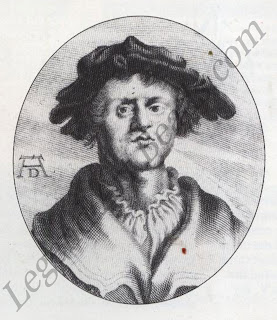

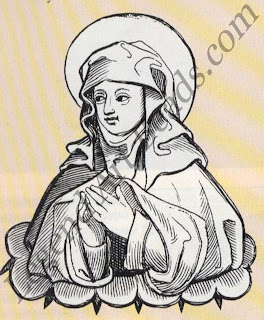











0 Response to "Introduction to German Great Artist – Mathis Grunewald"
Post a Comment